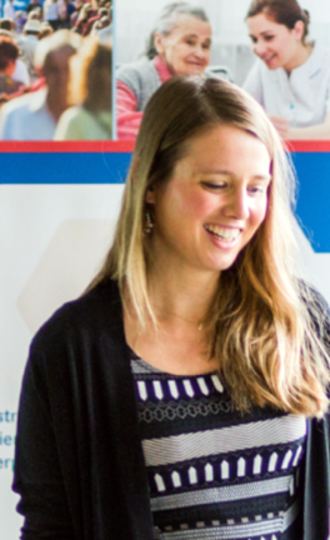Interview with Anne Maass: "We have a huge potential as a neuroimaging site".

Anne Maass is the first junior research group leader at the DZNE site in Magdeburg. In March, she started to build up her working group "Multimodal Neuroimaging" there. We talked to her about her start as a group leader and her research.
First of all, congratulations! How does it feel to be a new group leader?
Thank you so much! I am very much looking forward to the new task of setting up my own research group and implementing my research ideas. Of course it is a great challenge and responsibility to lead a group.
What is the structure like now? Surely you now have to buy equipment so that your employees can do any research at all, or do your colleagues help out?
Exactly, on the one hand I now have to build up a team and interview applicants and on the other hand I want to provide an efficient research infrastructure. In our research we collect large amounts of neuroimaging data. Magdeburg is very well equipped. With the help of the 7-Tesla MRI (magnetic resonance imaging) scanner available here, we can capture the structure and function of the brain with high spatial resolution. In addition, we can use PET-MRI (position emission tomography) to image Alzheimer’s disease proteins in the brain. Supported by our IT department in Magdeburg, I would like to provide my group with its own server, which enables efficient analysis and modelling of our multimodal imaging data due to its high computing power.
You want to use multimodal imaging to understand which memory networks are disturbed in old people and neurodegenerative diseases. What exactly does that mean?
Multimodal imaging in our case means the combination of molecular imaging (PET) and structural as well as functional MR imaging. Specific radioactive PET tracers allow us to detect the regional distribution of both amyloid and tau pathology in the human brain. Both proteins are deposited in Alzheimer's disease and show a stereotypical regional pattern of spread. Certain regions of the temporal lobe, an area of the brain, are affected very early by tau fibrils, which is associated with memory problems. These regions seem to play an important role in the recognition of objects. In this respect, we have recently shown that tau pathology in the temporal lobe was associated with reduced object memory in elderly individuals without symptoms of dementia. Furthermore, our multimodal neuroimaging data showed that the older subjects with more tau pathology also showed increased activation during the memory task.
Could practical approaches already be derived from this?
We are still at the beginning, but our data indicate the use of specific memory tasks as cognitive markers for Alzheimer's disease. In particular, longitudinal studies (within a subject over a longer period of time) are required to advance the development of cognitive and functional (fMRI) biomarkers for the early detection of dementia and the monitoring of disease progression. I am particularly interested in how the increased activity that we have been able to measure with fMRI is related to the spread of tau pathology. Our data and previous studies suggest a possible therapeutic targeting of hyperactivity in Alzheimer's disease.
You received a postdoctoral fellowship from the Helmholtz Association in 2015 and spent two and a half years researching in Bill Jagust's laboratory in Berkeley. Was the change to the us-American research landscape a major change to the way you worked in Magdeburg? Which insights from your time in Berkeley would you like to keep in your AG?
The time in Berkeley was unique and formative. I was particularly impressed by the motivation, creativity, efficiency and optimism of the researchers. However, I think that Magdeburg can well compete at international level, also with institutes like Berkeley. As a neuroimaging site, we have a huge potential and we can appear more self-confident outward. I think that passion for research, courage, and above all teamwork are essential to make a difference.
What inspires you about science in general and your field of research in particular?
With my contribution to research I can help to build up knowledge. I find that very motivating. Cognitive neuroscience in particular has always fascinated me. With the help of multimodal neuroimaging, I can now finally measure and better understand the direct relationship between age-related pathology, function and behavior in living humans. I am also interested in how some people remain cognitively unimpaired despite bearing pathology. Of course, one goal is to develop therapies that delay the onset and progression of dementia. We have already shown that a sports intervention can positively influence the blood flow in the brain and benefit memory performance in elderly. However, further studies are necessary to better understand the individual variability of neurovascular plasticity.
Thank you so much for the interview.
Follow Anne Maass @anne_maass
